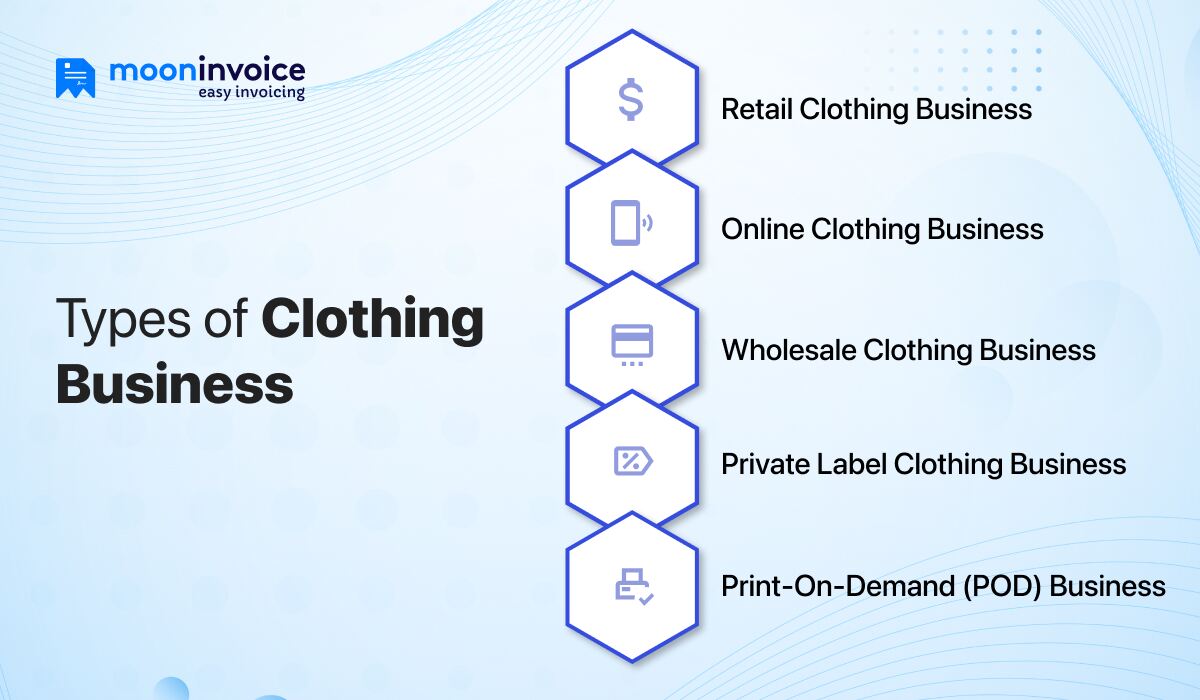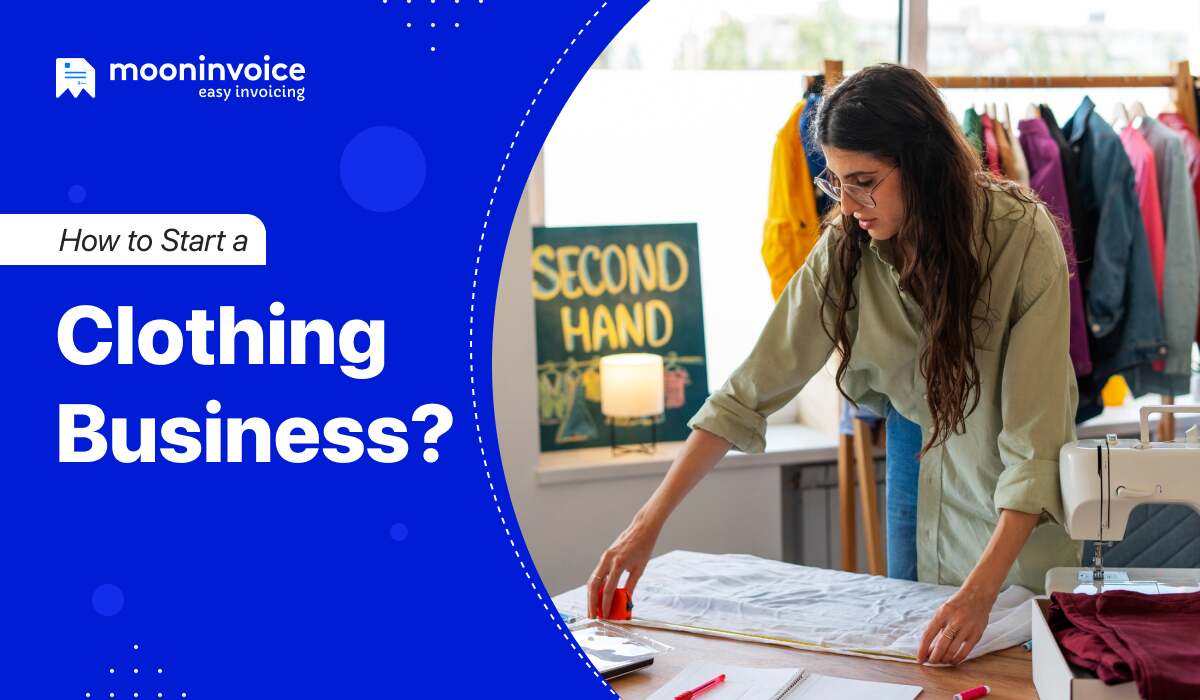Starting a clothing business doesn’t require any degree or special skills. If you know the design trends, evolving clothing styles, and are a bit enthusiastic about innovation, you can start your own clothing brand. Plus, the growth of e-commerce websites and online clothing stores is making sure fashion ideas can turn into profitable ventures.
According to Statista, in 2025, the worldwide Apparel market revenue is projected to reach a whopping USD 1.84 trillion. So, you can see the demand for trendy clothes is about to increase in the coming years with personalization and niche styles.
When you decide to launch your own business, it’s mandatory to understand the key steps that play a vital role in building a successful one.
In this blog, we will explore the steps of starting a clothing business, followed by common mistakes, and how managing finances can be a challenge. Let’s get started!
📌 Key Takeaways
- To start a clothing brand, you need to consider one specific niche rather than covering all categories to build a stronger brand identity.
- A well-defined roadmap helps you launch your business successfully, from budgeting and branding to product development.
- Don’t prefer poor material. Invest in quality materials and designs that reflect your brand value.
- To retain loyal customers, create content using social media, website, and email marketing.
- Use finance tools to simplify all your financial hassles like invoicing, expense management, reporting, and more.
Types of Clothing Business
 As you plan to launch your clothing brand, you must understand the difference between business models in the clothing industry.
As you plan to launch your clothing brand, you must understand the difference between business models in the clothing industry.
Each type of clothing business has its own workflow, customer base, and investment needs.
There are mainly 5 types of clothing businesses. Let’s understand it one by one:
1. Retail Clothing Business
A retail clothing business means a ready-made garment sourced from manufacturers or wholesalers. They sell clothes directly to customers through physical stores or online. In comparison to other types of clothing businesses, retail clothing stores have less online activity.
Advantages:
-
- Once vendor relationships are strong, they grow quickly
- No production risk as the clothes are pre-made
- A range of options (styles, brands) to offer to customers
2. Online Clothing Business
This type of clothing business prioritizes selling clothes through digital platforms, such as Amazon or a website. Currently, the online clothing business is one of the fastest-growing segments, due to its low start-up costs and wider reach compared to a retail store.
Advantages:
-
- Lower startup cost and no physical stores required
- Global audience reach with 24/7 availability
- Easy to track, analyze, and plan sales using analytics tools
3. Wholesale Clothing Business
The wholesale clothing line is a type of clothing business that offers a unique business goal. Here, the owner manufactures or partners with a manufacturer and sells a wide range of clothing in bulk. Small clothing garment or new clothing store owners always look for wholesale clothing stores to buy a bulk amount of clothes at a slightly lower rate. Initially, wholesale clothing can be a bit challenging, but once you know your vendors and customers, it becomes easier over time.
Advantages:
-
- Strong brand identity and loyal customer base
- High profitability due to bulk selling
- A broader reach to local customers
4. Private Label Clothing Business
In a private label clothing business, you can choose to design clothes or select pre-designed templates. Then, a manufacturer will produce garments under your brand name. Be it branding, pricing, or distribution, without your approval, nothing will change. In other words, you will control everything.
Advantages:
-
- Total control over the design and quality of your clothes
- Strong branding opportunities
- Higher profit margins compared to reselling
5. Print-On-Demand (POD) Business
This clothing business has also picked up pace in recent times. It is a type of clothing business that focuses on printed clothes only. Once a customer places an order, the printing process starts and is delivered within the timeline. Designs are uploaded to online platforms such as Teespring, and the rest is managed automatically.
Advantages:
-
- No need to worry about inventory or shipping
- No big money is required to start this business
- Great for artists, athletes, and movie-based theme designs
Now, you know what a clothing business is and its various types. Now we will move forward to understand how to start a clothing brand successfully.
Is Poor Finance Management Slowing Down Your Clothing Business?
Don’t let finances slow down the progress of your clothing business. From your first sale to scaling your brand, Moon Invoice helps you stay organized every step of the way.
How to Start a Clothing Brand in 2026?

STEP 1: Find Your Niche
Are you wondering how to start a clothing line from scratch? We got you. Here’s how you can proceed.
When you are starting a business, the foundation needs to be rock-solid. This is the reason why you need to find your niche. The progress of your business depends on the type of niche you select.
Instead of selling to everyone, focus on a particular segment that is trendy, adds value, and resonates with your product offerings.
Here are some of the popular clothing niches you can explore:
-
- Sustainable/Eco-Friendly Fashion
- Streetwear or Urban Wear
- Activewear or Athleisure
- Oversized Fashion
- Kids or Baby Clothing
- Luxury or Designer Wear
- Personalized Printed Tees
If you don’t know your niche or your target audience, your clothing business could get lost in the sea of selling clothes to everyone. However, with a clearly defined niche, you will be able to build a strong brand identity and attract more customers to your business.
STEP 2: Create a Business Plan
Your niche is set, now you need to create a realistic and achievable business plan. Consider your clothing business plan as the blueprint of your clothing brand. It means the right business plan will guide you to a more promising future and could attract investors (if needed).
Your business plan should be clear and concise, rather than complex. It should cover all the major aspects of your business.
Here are the key components of a clothing business to consider:
-
- Market Research & Business Overview: Define your brand, mission, and what makes it unique
- Analyze Competitors: What are they doing well? Where can you do better?
- Product Plan: List the types of clothing items you will sell
- Sales & Marketing Strategy: Define USP and create a roadmap to promote your brand with marketing campaigns
- Operations Plan: Sourcing, manufacturing, inventory management, and shipping logistics
- Financial Plan: Startup budget, pricing strategy, profit margins, revenue estimation, and funding needs
Creating the right business plan will keep your vision clear and goals measurable. Plus, another advantage is that it will make your clothing business more secure for loans or investor funding.
STEP 3: Develop Your Brand Identity
Before we discuss developing a brand identity, let’s clarify what it truly means.
A brand identity is not about creating an awesome-looking logo!
It is the idea, the voice, and the emotion your business conveys to the world. In a world full of new, trendy designs, having a strong brand identity sets you apart from others. Your brand identity will help you build trust and connect more effectively with your target audience.
Suppose you are starting a clothing business on Urban Wear or an Athleisure clothing line, your brand should reflect your values, vision, and audience demand every time.
Steps you need to follow to create a strong brand identity:
- Select a name that represents your niche and is easy to remember. Make sure the domain and social media handles are available.
- Consider a professional logo that builds credibility. Minimal, edgy, and classy styles are more recommended.
- Define what your brand represents – is it fancy, luxurious, or eco-friendly?
- Share the brand story. Share what the mission is?
- At last, define what you stand for. Is it inclusivity, affordability, or premium?
While developing your brand identity, don’t forget to look for ideas to prevent vendor fraud in your clothing business.
STEP 4: Design Your Products
Designing your product is one of the most important parts of starting a successful clothing business. This is where users will experience the look and feel of your product. With the right set of fashion trends, you can turn your brand vision into garments customers will wear, love, and recommend.
Your design must align with your brand identity and niche, while also being visually appealing.
You can start your design process by using the following practices:
-
- Sketch Your Ideas: Sketch your ideas using drawing boards or tools like Canva or Adobe Illustrator.
- Create a Tech Pack: Define measurements, type of material, stitch details, etc., to reduce sampling errors.
- Choose Fabrics and Materials: Your clothes should be durable, comfortable, and echo brand value. Before finalizing, one must consider these factors.
- Develop Samples and Prototypes: Create the first sample by working with a local tailor. Test the fit, feel, look, and style before going for bulk production.
Always prioritize quality and comfort above all because no matter how appealing it looks, customers should feel comfortable first. Only then will they buy it. Otherwise, it will just become a showpiece, no selling.
STEP 5: Source or Manufacture Products
Your design is finalized. Now, let’s move on to the process where you will turn your sample into an actual product and start selling it. This can be done in two ways: first, sourcing ready-made items, and second, manufacturing your own line. You can choose either of these options depending on your business model and budget.
Let’s explore in detail how these two options will work for you.
A. Sourcing Ready-Made Clothing
Here, you will purchase pre-designed garments from suppliers or wholesalers and brand them as your own. It works best for boutiques, retailers, or dropshippers who have a limited budget.
Pros:
-
- Low investment
- Quick to get into the market
- Minimal product risk
B. Custom Manufacturing
The title itself indicates what it is.
It is custom-made, meaning everything from fabric and fit to stitching labels goes through you and a manufacturing partner. It works best for premium or luxury clothing, or private label brands.
Pros:
-
- Total control over your clothes
- Unique and exclusive products
- Creates a brand identity
Be it sourcing or custom manufacturing, you need to figure out how you will bill your retail and manufacturing clients. To find the solution to this, consider checking out fashion invoice templates and staying ahead of your business.
Start with a small batch production to test product quality and customer feedback before placing a large order. This reduces risk and allows flexibility to improve.
STEP 6: Set up Sales Channels
Your products are ready. Now it’s time to decide how you will sell them.
Your brand type, cost to start, and customer preferences will determine how the sales channel should look. Whether you’re a small business dreaming of going big or a business eyeing to create a name in the fashion industry, the sales channel makes it happen.
Here’s how you can set up a sales channel for your clothing brand.
-
- Build Your Online Store : To create a clothing brand, the best possible way is to launch your product on your own e-commerce website. Use platforms like WooCommerce or WordPress and set up shipping options for every purchase.
- Sell on Marketplaces : Start indulging in existing market platforms like Amazon and eBay. It works great for startups with a limited budget to solidify their online presence.
- Use Social Media Platforms : Social media is not just about marketing; it’s also your sales channel. Set up Facebook Shops and Instagram Shops so that users can make direct purchases from posts.
STEP 7: Launch & Market Your Brand
After juggling through files, facts, plans, and designs, the time has come to launch your business. To start a clothing line in the right way, the business launch needs to be more than just going live.
It should be an event that grabs attention and draws in your first real customers.
Once your business is launched, it’s time to market it and turn attention into consistent sales. Your marketing plan should drive revenue and build lasting relationships with your customers.
At this stage, you are not only promoting your brand, but you are also marketing your business in the competitive world of the clothing industry.
Things to Know About Post-Launch Marketing:
-
- Develop a Content Strategy : Write blogs, tell a story through e-books, share styling tips, and upload behind-the-scenes videos on your social handles.
- Build Your Email List : Start email marketing from day one or look for alternatives like newsletters. This is important to retain loyal customers and keep them in the loop.
- Consider Paid Advertising : If your organic traction is gaining, invest in “Ads on Google” or social media. It boosts your reach, and new customers continue to come.
- Focus on Long-Term Brand Building : Build a community that lasts with your vision. For a community of loyal customers, your business structure and customer experience all come into play.
A strategic marketing plan helps you stay competitive and consistently sell your clothing. While taking orders from suppliers, perform invoice matching to avoid discrepancies in the financial workflow.
Struggling to Manage the Finances of Your Clothing Brand?
Build your brand. We will handle the numbers. Let Moon Invoice take care of your invoicing, expenses, and financial reports.
6 Common Mistakes to Avoid in a Clothing Business
Starting a clothing business is an exciting venture, but as a beginner, small mistakes can decline your progress. Some owners simply don’t focus enough and jump in straight. These kinds of actions result in the waste of time, money, and effort.
So, below are some of the common mistakes you must avoid at all costs for a successful clothing business.
1. Trying to Indulge in Every Category
Some clothing businesses lack clarity and try to be involved in every category, instead of targeting one specific niche.
2. Selecting Poor Clothing Material
To save money, businesses often opt for subpar materials, which becomes a major reason for their business failure.
3. Not Sticking to Market Standard Pricing
No research, no pricing strategy leads to this. When you overprice, you lose customers, and when you underprice, you lose profitability.
4. Not Selecting Reputed Manufacturers
Overlooking suppliers or manufacturers is another reason why many clothing businesses collapse midway.
5. Fail to Track Initial Sales
Some businesses fail to track their initial few sales as they spend more time growing the business. These types of inconsistencies disrupt the revenue count.
6. Unresponsive Customer Support
Slow and poor support services make customers switch to other brands.
Avoid the above-mentioned mistakes for a stable and long-term business.
How Moon Invoice Helps You Manage Your Finances?
Managing all your finances can be challenging, especially in a complex business like the clothing industry. Here, you will need to consider all sales data, including products/services received from suppliers or manufacturers, revenue, shipping, and many other factors. So, the question is, how to manage your finances effectively?
The answer is to use a feature-rich online invoicing software. If you use software tools like Moon Invoice, you can easily turn your financial hassles into productive outcomes.
Features that make Moon Invoice a must-have software for your clothing business:
- AI-Powered Quick Scan : You can quickly scan your paper copies and pull out accurate details while making bills and expenses.
- Professional Invoices : Create invoices for both retail and wholesale clients using free fashion stylist invoice template or free illustrator invoice template.
- Track Inventory & Sales : Manage available or running short stocks so you never oversell or understock your items with inventory tracking.
- Real-Time Financial Reporting : Access a dashboard that shows income, expense, and profit all in one place.
- Supports Multiple Payment Methods : Makes your invoice payment process faster and hassle-free with various online payment options.
- Recurring Billing : Set up recurring billing for repeated vendors or suppliers.
Be it a clothing business of any kind, Moon Invoice helps you manage your financial workflow seamlessly.
Wrapping Up!
Is a clothing business a good choice for a business? The answer is YES. Generally, we don’t see people considering the clothing business as an option compared to other businesses, such as tech startups, product-based startups, or even restaurant businesses.
However, in the last few years, the clothing business has grown significantly, especially the online version. It has reached a level where you can find any type of design or material you want simply by searching. But the only challenge here is managing your finances. This is the reason why you should always use a reliable solution like Moon Invoice.
No more complicated calculations. Track income, manage expenses, and send invoices all within one app. Get started with your free trial now!












![How to Calculate Net Sales [Net Sales Formula]](https://mi-blogs.s3.amazonaws.com/mi-live/blog/wp-content/uploads/2024/04/25100739/How-to-Calculate-Net-Sales-Updated-Guide-2024.jpg)





